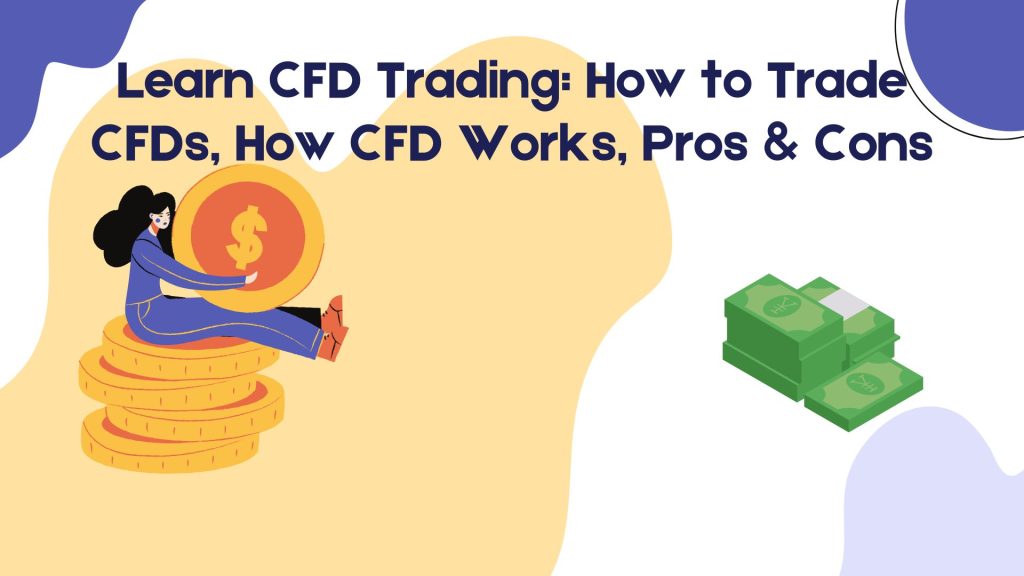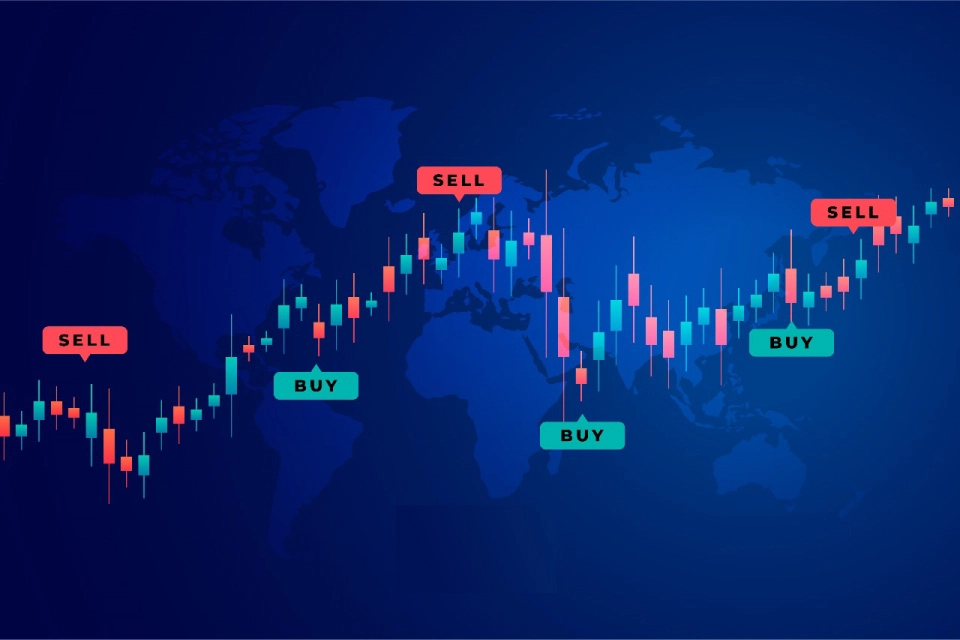To trade CFDs requires advanced knowledge of the market. Cautiously traded CFDs can be your ultimate profit-making instrument. It offers a multitude of benefits, among them the most exciting one is the possibility of earning by employing a falling market. So, if you are thrilled and convinced enough to trade CFDs, reading this guide should be your first step for making a knowledgeable entry into the CFD market.
What is CFD Trading?
The concept of CFD trading can confuse learners, especially those unfamiliar with the financial industry. For them, a better approach is to start by learning the basic terms related to CFD trading. Here are a few:
CFD: CFD stands for “Contract for Difference.” It is a financial agreement signed between two parties, usually a buyer and a seller, in which the buyer receives a right from the seller to speculate on the difference between the starting price and the closing price of an asset without buying the physical asset.
Derivative: Derivatives are financial instruments, like options, swaps, and futures, whose values depend on their underlying assets. Traders invest in derivatives instead of buying those underlying assets directly and make a profit or loss based on the price change of the assets. CFD is also a type of derivative.
Leverage: In a financial market like the Forex, stock, and Cryptocurrency markets, traders can borrow money from financial bodies, usually brokers, to purchase an order whose price exceeds the traders’ capital at hand. The money borrowed from a financial body to buy a greater amount of an asset is called “leverage.”
Margin: When a trader wants to purchase an order with leverage, he must deposit a minimum portion of the purchasing amount to the financial body or the broker from whom he takes the leverage. The required money to be deposited is called a ”margin.”
So, these are the fundamental terms or ideas beginners should be familiar with before learning about CFD trading. Now that we have covered them all, let’s proceed to the question, “What is CFD trading?”
CFD Trading
CFD trading involves buying and selling CFDs of different assets. Most traders use leverage while trading CFDs in order to capture a bigger portion of the market and make a higher profit, investing a minimum capital. CFD trading falls into the over-the-counter (OTC) trading category as both involved parties share counterparty risk, which means
If the price follows a buyer’s predicted course, he makes profits, and the seller pays. On the contrary, if the price deviates from the prediction, the buyer suffers a loss and pays the seller. The broker becoming
Example of CFD trading
Suppose, after conducting thorough market research, you have concluded an imminent price hike in the Gold market, increasing from the current price of $2000 per ounce to $2100 per ounce. So, you rush to your brokerage company and tell them you want to buy 10 CFDs where 1 CFD = 1 ounce of gold.
If your broker has a 5% margin requirement, you must deposit an initial amount of = The Number of CFDs X Current Gold Price X Margin Requirement = 10 X $2000 X 5% = $1000, which is your margin.
The total size of your purchase is = Current Gold Price X The Number of CFDs you are buying = $2000 X 10 = $20,000
So, your taken leverage amount = Total Purchase Size – Paid Margin = $20,000 – $1,000 = $19,000, at a margin-leverage ratio of $1000:$2000 = 1:20.
After a few days, manifesting your predictions, the gold’s price hikes to $2,100 per ounce, resulting in a profit amount of = (Hiked Price – Initial Price) X The Number of CFDs = ($2,100 – $2000) X 10 = $1000.
But if the market swings in the opposite direction and the price of Gold reduces to $1900 per ounce, you have to count a loss of = (Initial Price – Reduced Price) X The Number of CFD = ($2000 – $1900) X 10 = $1000.
Going Long and Going Short
Though CFD trading is much like trading an asset on the exchange, it has some distinguishing features. Apart from its tradability against leverage and dependability on the underlying asset’s value, CFD has one more unique trait. It offers traders a chance to profit even from a falling market. Let’s get into its details.
The term CFD spreads to “Contract for Difference,” emphasizing its two primary characteristics: it is a contract, and it is traded on the difference of price changes, regardless of the increase or decrease of the price.
We have already seen how CFD trading works in a bullish market where a trader predicts an imminent price hike and buys CFDs. In a contrasting situation, if a trader predicts that an asset’s price will decrease soon, he can take a selling decision, where his broker lends him CFDs to sell in the market. Later, when the price falls, the trader buys the same number of CFDs, pays his debt to the broker, and keeps the difference as profit.
Based on the direction a trader wants to go, CFD trading has two categories:
Go Long: Traders buy CFDs expecting a price hike
Go Short: Traders borrow CFDs and sell them in the market, expecting a price fall. If the price falls, traders buy back the same number of CFDs and make a profit.
Why Should You Trade CFDs?
CFD trading offers traders a few distinct edges over traditional trading on an exchange. Here are some advantages of CFD trading:
Leverage: CFDs are traded on leverage, with greater purchasing power and higher profit exposure.
Go Short: It is possible to make profits from a bearish market by going short with CFDs.
Diversity: CFDs are tradable on every financial market, so traders can choose from a vast number of assets.
Quick Cash Settlement: CFD trading doesn’t restrict a trader with a timeline. Traders can buy and sell their positions whenever they find it suitable.
Hedging: Hedging allows traders to offset the risks of a trade they are currently on by investing in other short positions.
Risks of CFD Trading
Multiple risks are associated with CFD Trading. If treated casually, they can end a trader’s career. Here are a few threatening aspects of CFD trading:
Counterparty Risk: Traders face counterparty risks like their brokers becoming insolvent or failing to pay.
Liquidation Risk: If the margin becomes insufficient to support trade, brokers can close traded CFDs.
Volatility: Reliant on sundry variables, prices fluctuate frequently in financial markets, diverging from analysis-made indications, perpetually leading to shortfalls.
FAQs
Why Should I Trade CFDs?
Trading CFDs offers multifarious benefits, including the capacity to be traded on leverage and profitability in a depreciating market. In simple words, traders can trade CFDs for higher gains at a low investment margin beyond market conditions.
Can I Hedge With CFDs?
Yes, with proper strategies, you can hedge with CFDs to offset a clear shortfall. While hedging, make sure you are buying short, and your hedge is pursuing the opposite direction of the current trade.
Are CFD Profits Taxable?
CFDs’ taxability is variable by country. Some countries permit tax-free CFD trading, while others impose additional tax on profit. Consult your broker and governing jurisdictions to learn more.
Do CFDs Have Expiration Dates?
No, CFD trading doesn’t confine traders to a limited timeframe. Traders can enter or leave a trade at any suitable time.
What Are The Risks Of CFD Trading?
CFD trading suffers from common risks associated with the decentralized financial market, such as market volatility and a long learning curve. There are also a few esoteric risks, including higher risks tagged with leverage, margin calls when brokers can sell your positions without notice, additional charges, like overnight fees, and interest rates on the leverage.
Conclusion
Getting a good grasp of the concept of CFD trading can open a world of opportunity for you. But one slip in your judgment or a tiny crevice in your knowledge can scramble your chance for gains, additionally creating negative capital in your profile. So, before making your move, lean on your back and study the ins and outs of CFD trading.



